This is a technique I’ve been wanting to try for ages. Since last year, in fact, when still living in Rome. There, I encountered the blog of another ex-pat baking enthusiast, Krumkaker. She made several of her loaves in a casserole dish. It’s also a technique demonstrated by the ever-enthusiastic Vincent Talleu here.
I didn’t have my Le Creuset, or similar, with me while living in Rome, but now I’m home, I’ve found it. (Though we’ve lost a load of other baking kit in our double move. Particularly sad is the loss of an Eiffel Tower-shaped cake mould Fran bought in Paris with our dearly missed late friend Sara.)
Anyway. I’m not sure baking in a cast iron casserole, or Dutch oven, or Le Creuset, is a Scandinavian technique. It’s likely something that just evolved before Europeans had ovens, and would bake in pots, initially earthenware.
On the road
The only other time I baked in a Dutch oven was in New Zealand, 1989, when I was on the road with my old friend Stephen McGrath, his Clydesdale horses and an elaborate caravan of wagons and carts. I made an enormous, heavy-duty loaf in a massive Dutch oven, baking it in the embers of our campfire.
The logic of baking in a casserole dish is that the cast iron is not only nice and hot – you preheat it – it also traps the moisture of the dough, effectively steaming the bread as it bakes.
Steam is how you get a crisp crust on bread, and can be difficult to create in a domestic oven. Professional baking ovens have steam injectors, but domestic techniques using misting sprays or trays of water are never quite as good. I can’t remember the qualities of my campfire loaf all those years ago (25!!!), but certainly this loaf has a lovely crust – though it wasn’t the crispest I’ve managed over the years in a domestic oven.
It also has a very satisfying shape, and the dish constrains any dough flow if I hadn’t moulded the ball well enough. (I hate it when I make a round free-form loaf, forming the dough into a ball, then it flows out into a discuss shape when it take it out of the proving basket; shaping nice tight balls can be surprisingly tricky.)
Rude health
This loaf is also my first sourdough for a while. Although I’ve been making most of my own bread since we got back to England at Christmas, I’ve been neglecting my leaven somewhat.
Now about five years old, my leaven is well-travelled and much changed. It was born in London, then moved to Sussex, then it moved to Italy with us. There, it was fed on many and varied Italian flours – wheat, rye and various things referred to by the much misunderstood term farro.
Then it moved back to Britain. And I abandoned it for a few months. While we visited friends and family in the US and NZ, the sourdough lodged with my mother. Who’s a great cook, but not a bread-maker – she’s doesn’t make bread with easy yeast, let alone have any experience with sourdough.
So the past few months I’ve been nursing it back to health. I fed it rye, and local stoneground wheat flour, and filtered water. Finally I introduced some other leaven, from third generation baker Michael Hanson of The Hearth in Lewes. This could be seen as cheating, but I see it more like a kind of marriage. The yeasts and bacteria in my (puny) leaven mixing with those in Michael’s leaven. And after weeks of TLC, it’s finally back in rude health.
Mad science
As with much of my bread-making, this is kinda experimental, not a recipe as such.
I made a sponge with:
300g water
80g wholewheat leaven (at 100% hydration)
200g strong white bread flour
All mixed together, and left, covered with a shower cap – another technique I learned from Krumkaker.
I left it all day, for about seven hours, while I went off and worked in The Hearth.
In the evening, I made up a dough, with a further:
100g white bread flour
150g wholemeal wheat flour
10g salt.
I gave it a short knead, formed a ball, then let it rest for about 10 minutes. I then gave it another short knead, another 10 minute rest, and repeated this a few more times. I then left it an hour, at room temp (about 18C). I then gave it a fold then put it back in the bowl, covered it, and left it in the fridge overnight (4C).
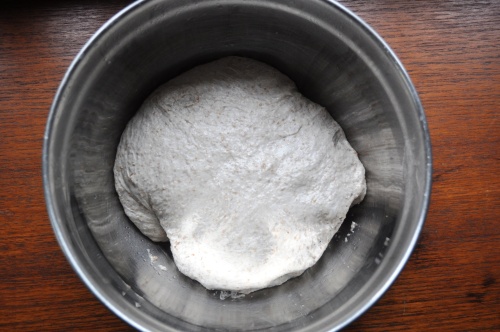
In the morning, I gave it another fold, resting it at room temp for another hour, then formed a ball, rested it 10 minutes, tightened up the ball, then put it in a basked and gave it a final prove in the airing cupboard (about 24C).
I then preheated the oven to 250C, with the Le Creuset inside. After about 20 minutes, with the oven at heat, I turned the well-floured dough out of the proving basket and dropped it into the hot dish – taking care not to roast my knuckles. I didn’t slash the top – because I wanted to see how it cracked. Or because I forgot.
The lid went back on and I baked it for about 25 minutes at 220C. I then took off the lid, dropped the temperature again to 200C, and baked for another 20 minutes or so.
The results were good. The crust is more chewy than crisp, the crumb soft and moist. We had some for dinner, when I did wood pigeon breasts with a pancetta, thyme and juniper berry red wine sauce. We didn’t eat all the meat, so Fran used the leftovers for a sandwich for work, with a smear of wild garlic sauce. I bet no one else had that posh flavour combo sarnie* for their work lunch today.
* Any US readers, “sarnie” is British English – possibly even English English – slang for sandwich.


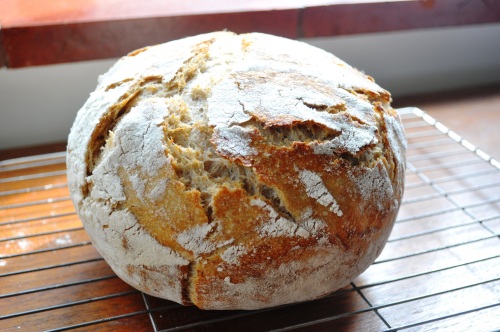
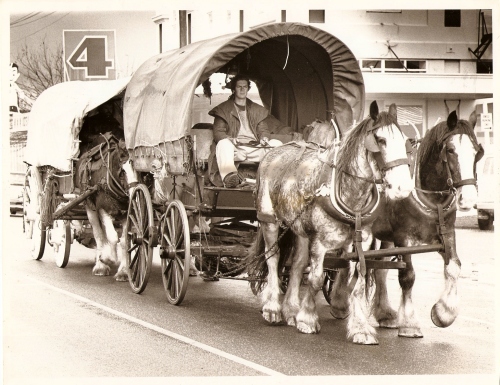

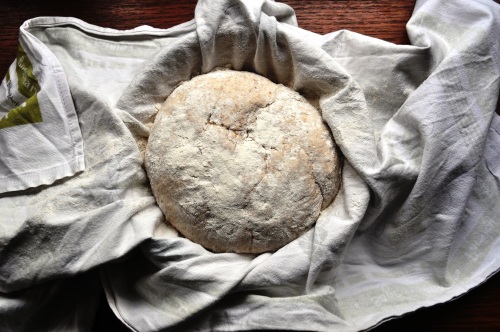
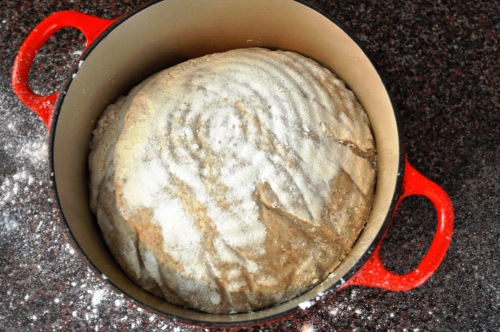
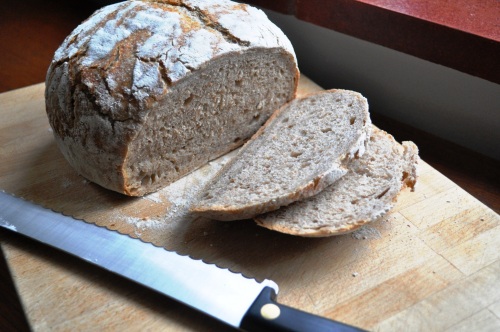
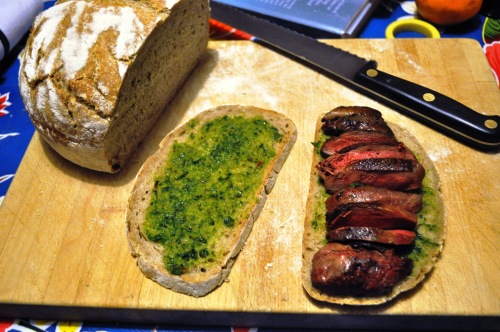
That looks fantastic bread. I might even try. Great photo of you in NZ. I had forgotten it. But the photos of the bread make me hungry even early in the day. Michael
You should do – make a basic yeasted dough, and try baking it like that.
So glad my benign neglect of your leaven has been remedied and it is well again. Shall look forward to trying your sourdough when we visit next.
I like the look of that sarnie! Lovely looking loaf.
With packed lunches like that, I’m amazed Fran has such a fabulous figure!
Ha, it’s not every day she gets a lunch like that. First time I’ve cooked pigeon if memory serves (though I butchered loads at the American Academy in Rome).
Nice work Dan. I’ve also baked with a cloche — in my case earthenware rather than cast iron — over the loaf on a tray, and that has very similar results. Doesn’t contain the loaf as well, mind.
Another technique to put on my to-try list then Jeremy.
That looks amazing Dan, I love the natural cracks in the top too. Wish I could achieve a loaf as good looking and tasting. Catherinex
Yes, I was pleased with the cracks – it was well worth forgetting to slash the top! I’m sure you could do a loaf as good.
Lovely Daniel … thank you so much for sending! Date: Thu, 3 Apr 2014 08:22:49 +0000 To: pinojo@hotmail.com
What a bloody beautiful loaf, I want to make this, I need advice on how to make a starter. Also what a beautiful lunch – Skype asap
You could make this style loaf with normal yeast, but yes, get a leaven going – not too tricky, as long as you look after it!
I have two starters available …
Daniel, such a beautiful post and really such a wonderful looking loaf. I want one of those sardines, but making do with a slice of Lariano with english salted butter. I have never made a levity madre, in fact never really made bread. I feel quite inspired to try. Have the le creuset, lugged it over from Aus in my case a few years back. Keep baking.
Hi Alice – yes, try some bread-making, it’s so rewarding. Not hard, just needs a bit of planning.
What a lovely loaf! I am bookmarking this to try next weekend, that is beautiful.
A pleasure to actually meet your starter. Love to hear the history of people’s leaven. Mine descends from a batch my mother was given in the 60s in Glacier National Park, from a hippie who got it from another hippie backpacking in Denali National Park. I have given snips to many friends, one in particular who started a deep dish pizza restaurant in Chicago. Would love to see a genetic linking map to show genealogical patterns of our bread yeasts…ha. And sarnie? That is a first for me!
Wow, your starter has some serious heritage Rachel. Hope mine lasts a few generations like that.
I am a massive fan of this method of baking bread and have used it for lots of different bread recipes. Foolproof and always tasty.
I do not like this method: hardly it can be used when it is necessary to bake one loaf and completely unacceptable when it is necessary to bake a lot or just more.
Arguably it’s not so good for commercial production, I find it fine for doing just one loaf at home, and it’s certainly easier than a free-form loaf. I reckon in my new oven I could do batches of 3 with the three heavy casserole / Le Creusets I’ve got.
Hi Daniel, this certainly looks worth a try. What size le Creuset is that please?
Hi Barry. I’m not sure of its volume, but it’s quite small – 185mm diameter, 85mm depth.
That’s great. Thanks Daniel
Thanks, your article is really helpful.
I tried my usual sourdough loaf this way and the result was fantastic. The shape was perfect and the crust was awesome!
You’re welcome. I’ve not done it for a while, so a timel reminder.